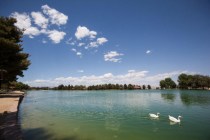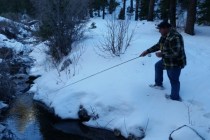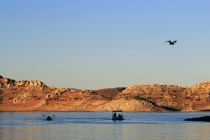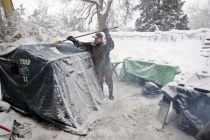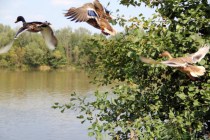Keep in mind that to launch your tube, you need to be able to walk into the water backward, and there is no graceful way to get into a tube. Look for someplace where you can wade backward without stepping off a steep underwater slope.
- Home
- >> Sports
- >> Sports Columns
In The Outdoors

Freelance writer Doug Nielsen is a conservation educator for the Nevada Department of Wildlife. His “In the Outdoors” column, published Thursday in the Las Vegas Review-Journal, is not affiliated with or endorsed by the NDOW. Any opinions he states in his column are his own.
intheoutdoorslv@gmail.com
No one knows for sure who invented the first float tube or what its origins were, but we can be thankful today that someone gave in to their curiosity and gave it a whirl.
Ty Dillon is the grandson of Richard Childress, owner of Richard Childress Racing and a former NASCAR driver. Ty’s father is former driver Mike Dillon, and his older brother Austin drives as well. And Ty loves the outdoors.
It won’t be long before the ice begins to melt away from the shoreline on reservoirs to the north and opens the door on some of the best trout action of the year.
It is amazing how fast and how drastically things can change in a decade or two. Technology has turned our world upside down on many fronts and in equally many ways. Not only in regards to home or work but also things outdoors.
The Federal Land Policy and Management Act of 1976 basically lays the modern foundation and establishes policy for the management of America’s public lands.
The sun was sinking low on the horizon as The Wildman and I emerged from the mouth of Carpenter Canyon.
When it comes to firearms, I have a thing for guns with a little bit of history behind them.
If speed is what you like in your sporting firearms, speed is what you are going to get out of the newest rifle cartridge from Weatherby. The company is so proud of the speed generated by this cartridge that it’s branding it as “the fastest production 6.5mm there is.”
The shotgun bucked against my shoulder and the clay target disappeared in cloud of orange and black dust. At that moment, a smile came to my face. Not because the shot was something spectacular — it wasn’t — but because it was the first clay target I have broken since having shoulder surgery in July.
After reading my Dec. 24 column about ice fishing, Doug Thayer shot me an email asking “why no mention of Cave Lake in Ely?”
As a general rule, foul weather is a blessing for duck hunters. Winds and cloud cover associated with weather fronts help to increase daytime bird activity and reduce glare from shotgun barrels and hunters’ faces, which can then translate into increased opportunity and success for waterfowl hunters.
In some parts of the country, ice fishing is serious business, an outdoor pursuit undertaken with an almost religious fervor. Those of you who hail from the upper Midwest know what I am talking about and probably can trace the ice fishing gene back through your genealogy.
Fall 2006 was a banner hunting season for upland game bird hunting in Southern Nevada.
Winter weather and freezing temperatures have settled in over much of Nevada, and that means popular trout fishing destinations to the north of Las Vegas have either iced over or are well on their way. While that is good news for the dedicated ice fisherman, some fair-weather anglers tend to see iced-over waters as a sign that it is time to put their fishing rods away until spring.








